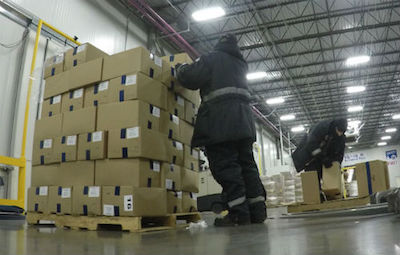Apr 25th 2024
Warehouse & Distribution Safety
In the past 15 years, the warehousing and distribution workforce has surged to almost 2 million individuals, as reported by OSHA (think Amazon). With this significant growth in workforce numbers comes an increased array of hazards to navigate. Some of the common hazards that warehouse and distribution workers face include:
Slips, trips, and falls

Due to the fast-paced and often crowded nature of warehouses, workers are at risk of slipping on spills, tripping over clutter or uneven surfaces, or falling from heights such as ladders or platforms. To prevent these accidents, it is essential for employers to implement proper safety measures. This includes keeping walkways clear of clutter, promptly cleaning up spills, providing proper lighting, and installing handrails on stairs and platforms. Additionally, employees should be trained on proper lifting techniques and how to navigate slippery or uneven surfaces. It is also important for workers to wear appropriate footwear with good traction and to always be aware of their surroundings. By taking these precautions, the risk of slips, trips, and falls can be greatly reduced, creating a safer work environment for everyone in the warehouse.
Lifting and musculoskeletal injuries
Lifting and musculoskeletal injuries: Workers in warehouses are often required to lift heavy objects, leading to strains, sprains, and other musculoskeletal injuries. Proper training and use of equipment such as forklifts, pallet jacks, and lift assists can help prevent these injuries. Employees should be trained on proper lifting techniques, such as bending at the knees and using their legs to lift, rather than their back. They should also be encouraged to ask for help when lifting heavy objects that they cannot safely lift on their own. Employers should also provide workers with the appropriate equipment needed to lift heavy objects safely. This may include forklifts, pallet jacks, and lift assists, which can help reduce the risk of injury. Regular breaks and rotation of tasks can also help prevent musculoskeletal injuries by giving workers time to rest and recover from repetitive lifting tasks. It is important for employers to prioritize the safety and well-being of their employees by implementing proper training, equipment, and procedures to prevent lifting and musculoskeletal injuries in the workplace.
Forklift accidents
Forklifts are commonly used in warehouses to move heavy goods, but they can also pose a significant safety risk if not operated properly. Workers can be injured by forklifts tipping over, running into objects or people, or if they fall from the forklift. To prevent forklift accidents, it is important for operators to be properly trained in forklift operation and safety. They should always follow safe operating procedures, use seat belts, and be aware of their surroundings at all times. Additionally, regular maintenance and inspection of forklifts can help prevent mechanical failures that could lead to accidents.
Employers should also ensure that their warehouses are organized in a way that minimizes the risk of forklift accidents, such as keeping aisles clear and properly marking designated pedestrian walkways. It is also important to provide adequate lighting and warning signs to alert workers of forklift activity in the area. In the event of a forklift accident, it is important to follow proper protocols for reporting and investigating the incident. This can help determine the root cause of the accident and prevent similar incidents from happening in the future.
Overall, forklift accidents can be prevented with proper training, maintenance, and safety protocols in place. By prioritizing safety in the workplace, employers can create a safer environment for their workers and reduce the risk of accidents involving forklifts.
Hazardous substances
Many warehouses store and handle hazardous materials, such as chemicals, flammable liquids, or compressed gases. Workers need to be trained in proper handling and storage procedures to minimize the risk of exposure to these substances. Safety data sheets (SDS) should be readily available for all hazardous substances in the warehouse, outlining the potential health hazards, proper handling procedures, and emergency response measures. It is important for workers to be familiar with these SDS and know how to access them in case of an emergency. Proper labeling of hazardous materials is also crucial to ensure that workers can easily identify the substances they are working with and understand the associated risks. Workers should always wear appropriate personal protective equipment (PPE) when handling hazardous substances, such as gloves, goggles, and respirators. Spill control measures should be in place in case of accidental releases of hazardous materials. Workers should be trained on how to respond to spills safely and effectively, including containing the spill, cleaning it up, and disposing of contaminated materials properly. Regular inspections and maintenance of storage areas for hazardous substances are essential to ensure that containers are properly sealed, labeled, and stored according to OSHA regulations. Proper ventilation systems should be in place to prevent the buildup of fumes or vapors that could pose a health hazard to workers. Overall, proactive training, proper labeling, safety measures, and emergency response protocols are all essential for minimizing the risks associated with handling hazardous substances in a warehouse setting. By following these best practices, workers can reduce the likelihood of accidents and injuries related to hazardous materials in the workplace.
Vehicle accidents
Warehouse and distribution facilities often have a high volume of vehicles moving in and out, including trucks, delivery vehicles, and employees on foot. Workers are at risk of being struck by moving vehicles or getting caught in between vehicles. To prevent these hazards, employers should provide comprehensive safety training, enforce safety protocols, maintain a clean and organized work environment, and provide appropriate personal protective equipment. Regular inspections and audits can also help identify and address potential safety risks in the warehouse. By prioritizing safety, employers can protect their workers and reduce the risk of accidents and injuries in the warehousing and distribution industry.
As the warehousing and distribution workforce has expanded to over 1.9 million individuals in the past 15 years, as reported by OSHA, it's evident that the industry is experiencing substantial growth. However, along with this growth comes a heightened awareness of the multitude of hazards that workers face daily. It's imperative for businesses to prioritize safety measures and invest in comprehensive training to ensure the well-being of their workforce and the success of their operations in this evolving landscape. A range of tools is available to help business operators to reach work place safety goals in the warehousing and distribution environment.

